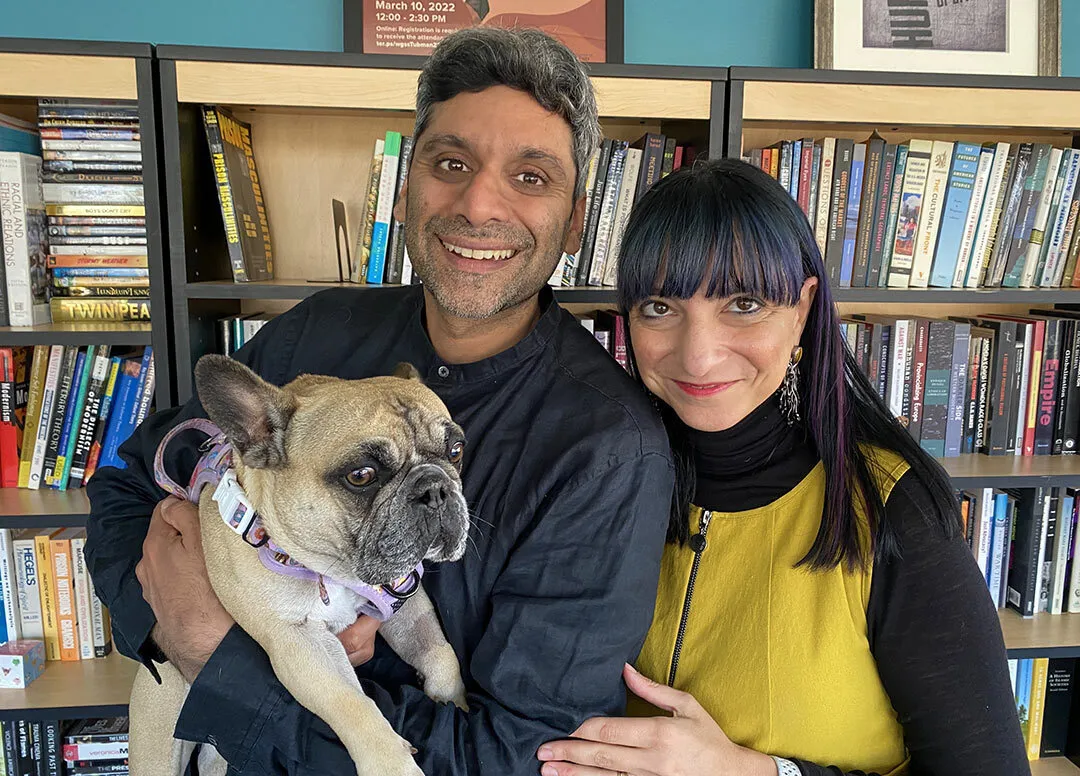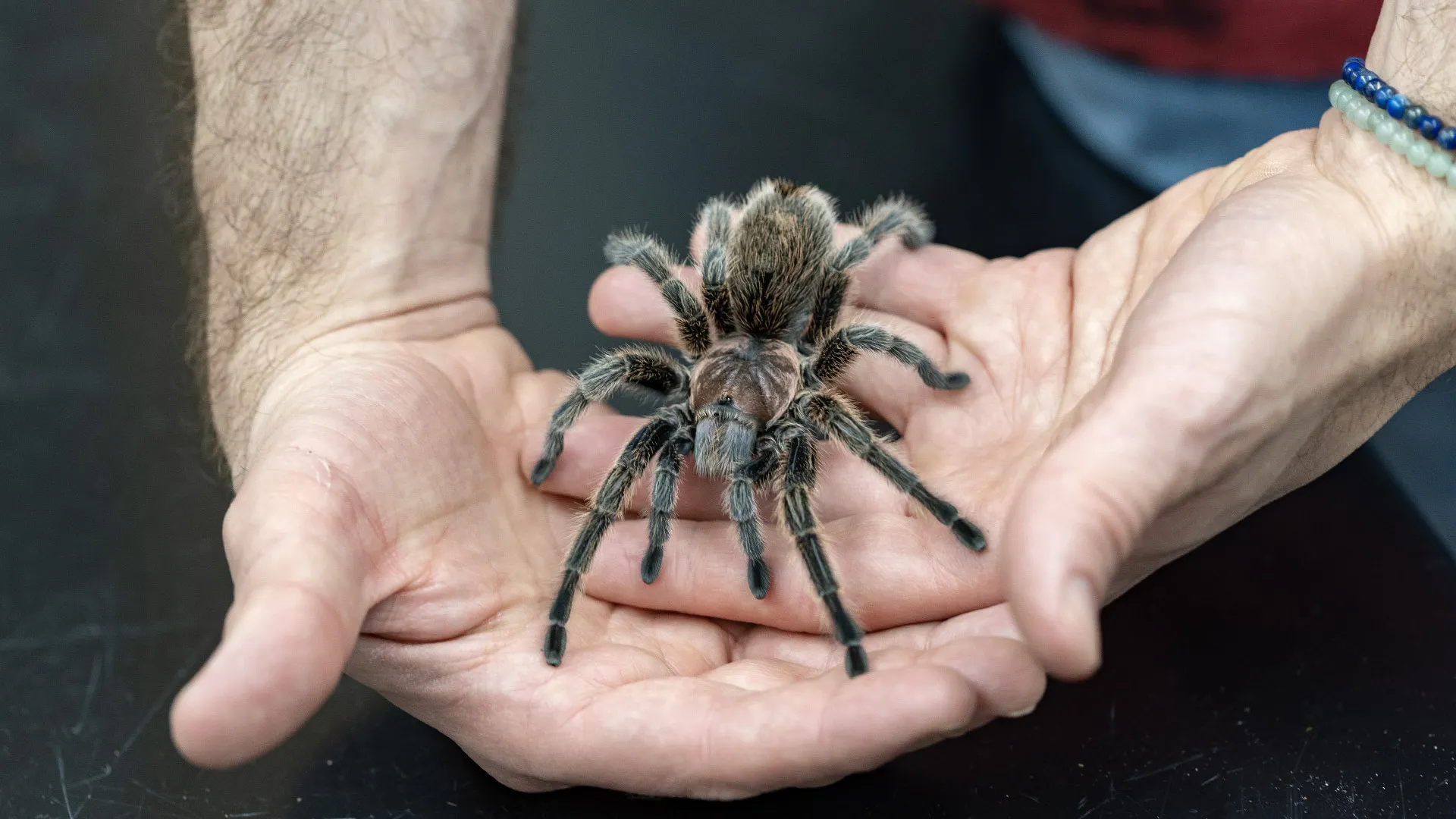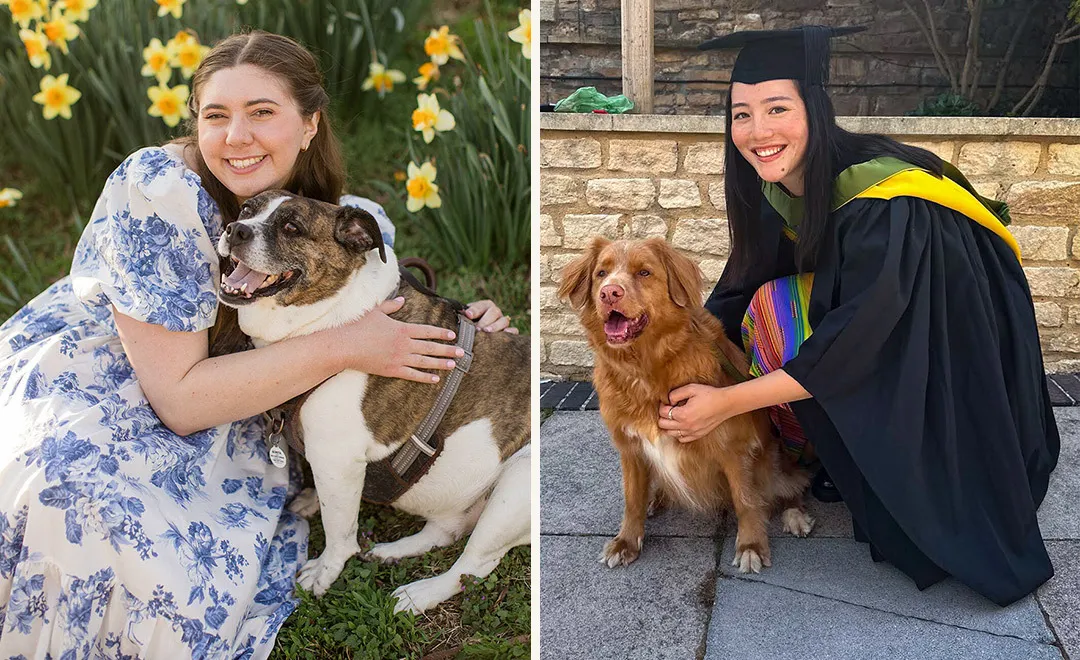- March 31, 2025
- By Sala Levin ’10
Testudo reigns as the University of Maryland’s ultimate mascot—that’s undisputed. But across campus, other animals represent their units in a more intimate, informal capacity.
From sniffing out treats hidden behind office doors to offering students stress-soothing snuggles to delighting visitors at Maryland Day, these creatures create enduring memories and bonds. (Yes, most of them are dogs; cat lovers seem to keep their felines at home.)
Here, Maryland Today takes a furry look at some of the beloved critters that serve as symbols of Maryland pride.

Blue
Six-year-old Blue is a campus bridge-builder. Once, as his owner Julie Gowin, lecturer and outreach coordinator in the Department of Communication, was walking from her parking spot in Mowatt Lane Garage, she heard an unfamiliar voice calling, “Hey, Blue!” “This guy in a truck stops in the middle of the road and gets out and pets him,” she said. The man was a Facilities Management staffer Blue had previously met, leaving a lasting impression.
Part black lab, part white Swiss shepherd, part husky and part beagle, Blue manages to break through even to the most difficult-to-reach demographic: cat people. “One of my colleagues only had cats and wasn’t comfortable with dogs, but she’s really connected with Blue” by interacting with him in Skinner Hall, said Gowin. “She says, ‘I have to have my Blue time!’” Blue even bridges Big Ten rivalries; Gowin generously allowed her husband, a University of Michigan alum, to name the dog—his first—for his alma mater.

Edgar
Since the return to in-person classes after the COVID pandemic, Edgar has been a frequent presence in the Parren J. Mitchell Art-Sociology Building, where he prowls the kitchen and lounge at lunchtime, “just in case someone is eating and might want to share a bite,” said his owner, Abigail McEwen, associate professor of art history and archaeology focusing on Latin American art.
The 9-year-old rescue, “a mutt of unknown origin,” said McEwen, visits classes where students are comfortable with dogs. Though generally quiet, he is also adventurous, said Marco Polo Juárez Cruz, a Ph.D. candidate in art history and archaeology, getting comfortable exploring the building and making new friends.

Fiona the Brave Knight
When Tim Knight, director of the College Park Scholars’ Environment, Technology, and Economy (ETE) cohort, adopted a German shepherd puppy last year, her name was listed on the rescue group’s website as Fiona the Brave. During her first visit to the vet, the doctor’s office added his last name. Thus, Fiona the Brave Knight was born.
Now, Fiona is a beloved part of the ETE community. Every other week or so, Knight brings her to the courtyard of the Cambridge Community, where students stop for pets and chats. “I’ve had sophomores and first-year students together in a very casual setting,” Knight said. “It’s an opportunity to get together and have conversations.” At the end of the academic year, Fiona accompanies Knight to the field day celebration for ETE students.
He hopes that Fiona’s presence can bring some joy to Terps who may be anxious about academics or personal issues. “Student mental health is a huge deal,” he said. “Students miss their pets at home.”

Lulu
French bulldog Lulu started making visits to the Harriet Tubman Department of Women, Gender, and Sexuality Studies (WGSS) simply because of his “clingy” nature, said his owner, Neda Atanasoski, professor and chair. She and her partner, WGSS Professor Neel Ahuja, took in Lulu after the peak of the pandemic, speculating that he’d been a COVID adoption gone awry. (“He came with the name Lulu,” Atanasoski said. “Neel and I were like, ‘We definitely have to keep this name. It’s perfect for two women and gender studies professors.’”)
Elece Smith, WGSS program administrative specialist, quickly jumped on the Lulu bandwagon. She began posting on Instagram when “dog office hours” were in session, and visitors would come from far and wide. “I remember one person who came from SPH,” Smith said. For students, “he’s a calming presence,” said Smith. “Everybody wants to pet a cute little dog.”

Pakora
When the COVID-19 pandemic hit and classes turned to Zoom, Millard and Lee Alexander Professor in chemical physics Pratyush Tiwary quickly realized that he needed a way to connect with students as more than just a presence on a screen. He was teaching a 100-person class in physical chemistry—a notoriously difficult subject—when one day, a student showed up for virtual office hours distraught about their homework. Tiwary’s dog, Pakora, jumped onto his lap and into the Zoom screen. Immediately, the student smiled. “It just hit me: This is a game-changer,” said Tiwary.
Tiwary set up a Slack channel for the class in which he shared pictures of Pakora—named for the Indian fritters Tiwary and his wife, Assistant Professor of geology Megan Newcombe, shared at restaurants while dating—and asked students to post pictures of their own pets. Soon, snapshots of cats, dogs, rabbits, hedgehogs, even a goat and a horse, came flooding in. “The whole class suddenly became more human,” Tiwary said.

Rosie the Tarantula
Certainly the most popular eight-legged creature on campus, Rosie the Tarantula is the spider queen of the Department of Entomology. A Chilean rose tarantula, Rosie is actually the department’s second Rosie. (Like Lassie, Rosie is a title passed down from animal to animal.)
The first Rosie belonged to the late J. Lee Hellman, founding director of the Life Sciences cohort of College Park Scholars and a UMD alum. Hellman was an insect collector, and on Ag Day—the predecessor to Maryland Day—he’d invite visitors to hold his scorpions, walking sticks and spiders. Today, Michael Raupp, now professor emeritus of entomology, is Rosie II’s main caretaker.
Now in her teenage years, Rosie II “is so much fun and so rambunctious,” said Raupp. “Teenagers just want to have fun.” Chilean rose tarantulas are among the most docile of all spiders, making Rosie an ideal candidate to face excited and anxious toddlers and college students at Maryland Day. “After being held in a thousand hands, poor Rosie is just exhausted at the end of the day,” said Raupp. “Sometimes she’ll just snuggle into a nice warm hand, and I think she’s taking a nap in there.”

Scout
The unofficial mascot of the Department of Agricultural and Resource Economics looks a little different than she used to. Last May, Scout, owned by Professor and Chair Ken Leonard, came in from her family’s backyard limping. A visit to an orthopedic veterinarian showed that Scout had broken her kneecap, and the only way to save it was with an experimental surgery that would require three months of heavy sedation to keep Scout from moving. Instead, Leonard and his family opted to amputate the leg. “That was a tough decision,” he said.
Now, the 10-year-old Australian cattle dog happily bounces around on three legs. She’s learning to use an assistive device, but most of the time Scout doesn’t need it to suss out the treats she knows certain campus figures hide in their offices. She’s also made other canine pals on campus; she and University of Maryland Police Department comfort dog Teddy the Terp can be seen together on Scout’s Instagram account.

The VIP Researchers
The Language, Experience, and Development (LEAD) lab in the College of Education, led by Assistant Professor Rachel Romeo, has an unusual tab under the “People” section of its website: the VIP Researchers. No, they’re not postdocs or visiting professors. They’re Very Important Pets.
The homage to the 15 dogs and cats that belong to researchers in the lab “celebrates their informal contributions to our ability to do research,” said Ellie Taylor-Robinette, a doctoral student. “A lot of us go home and see our animals and get some joy and cuddles from them.” (Taylor-Robinette is the owner of Bonita, a beagle/English bulldog mix named after A Tribe Called Quest’s song “Bonita Applebum.”)
“I remember discovering the pet page when I was stalking the lab before my interview to join and being like, ‘Okay, they’re nice, they’re not scary,’” said Alicia Mortimer, the lab manager, whose dog is a Nova Scotia duck tolling retriever named Hudson.
The Inanimate Mascots
Not all campus mascots walk on four (or more) legs. Some are a little less full of life, but no less full of spirit.
Hugh the Manatee: This aquatic mammal is the symbol of Honors Humanities. (Say it slowly: “Hugh … Manatee.”)

Kerpie: Ilya Albert, marketing and communication coordinator in the University Career Center (UCC), created this Muppet-style puppet to represent the UCC. “His backstory is that he’s Testudo’s wacky cousin who works at the Career Center,” said Albert.
Tipple: Lattisha Hall, business director of the Department of Teaching and Learning, Policy and Leadership, is known for the crocheted turtles her daughter makes that go by the name Tipple.
